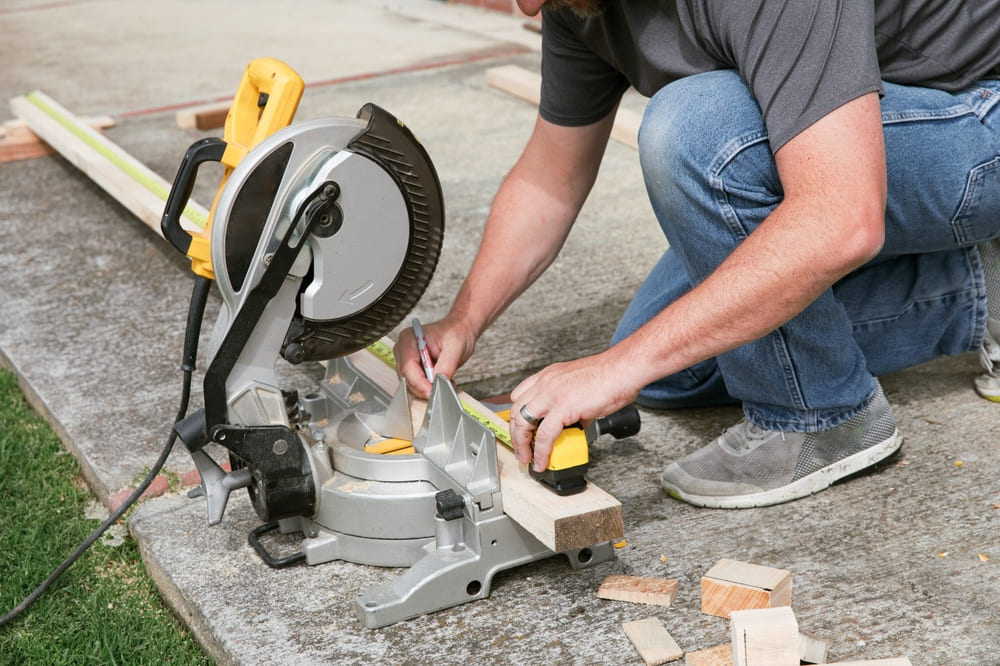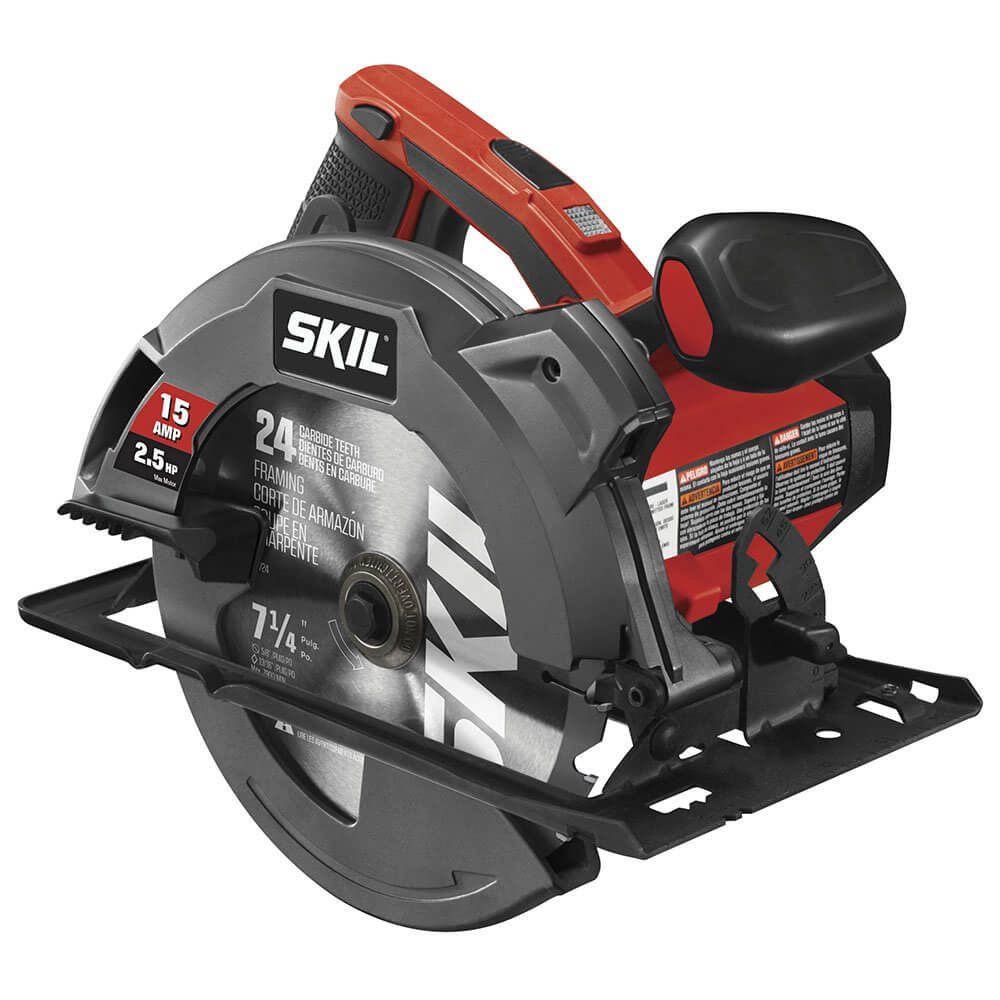YOUR NO 1 WOODWORKING POWER TOOLS RESOURCE WEBSITE
Choosing Between Miter Saw or Circular Saw for Woodworking Projects (Ultimate Guide)

Disclosure: If you click on some of the links, we may earn a small referral fee. Please know that we only recommend products that we use and believe will add value to our readers.
When I recently got started with woodworking projects, I wasn’t sure if I should go for a miter saw or circular saw. That was the start of my week-long research, which consisted of looking all over the internet and talking to people with experience in woodworking.
The conclusion that I came to is – they are both great, and the one that I should choose depends on my projects, preferences, and experience level.
For instance, as a beginner, I should go with the circular saw. But if my projects require crosscuts, then the miter saw is a must.
Of course, this will not help you find the answer you were looking for. That is why I have constructed an ultimate guide for you, which will help you decide between the two. So, let’s not wait any further.
Miter Saw vs Circular Saw (Summary Table)
|
|
Miter Saw | Circular Saw | |
|
Types of Cuts |
Crosscuts, miter cuts, beveled cuts, and angled cuts | Rip cuts, compound cuts, and dadoes | |
|
Width and Depth of Cut |
Width – up to 12 inches Depth – 4 inches | Width – up to 10 inches Depth – 2-3/8 inches | |
|
Precision and Accuracy |
Make precise cuts at specific angles. Laser guides and digital displays for accuracy. | Not as accurate. Requires more skill to achieve precision. | |
|
Portability |
Heavy and not very portable | Lightweight and easy to transport | |
|
Ease of Use |
Easier to use for professionals | Easy for both beginners and professionals | |
|
Wood Materials Most Suited for |
Thicker and wider wood pieces – can easily cut plywood | Smaller and thinner wood pieces – can cut thinner pieces of plywood. | |
|
Safety |
Built-in safety features | Requires caution | |
|
Price |
$100-$1000 | $30-$200 |
Brief Overview of the Miter Saw
A miter saw is a type of power saw used for creating precise crosscuts and miters in wood, plastic, and other materials. It comprises a base that supports the material being cut and a circular saw blade mounted on a swinging arm that can pivot left or right to make angled cuts.
There are different types of miter saws, such as the double bevel miter saw and single bevel, both of which can tilt the blade either way.
With its sliding function, the sliding compound miter saw can cut through wider boards by moving the saw blade forward and backward.
The laser miter saw also has integrated laser guidance that enables more accurate cutting. Here, we will discuss more about the miter saws and their uses.
Strengths of the Miter Saw
A versatile and effective tool, the miter saw shines at producing precise crosscuts and angled cuts. It is best used for woodworking, framing, and trim work because of its power to make precise, clean cuts swiftly and effortlessly.
When cutting numerous pieces of the same length or angle or when working with larger pieces of wood, miter saws are especially helpful. They are also excellent for creating compound cuts and beveled cuts, which are difficult to accomplish with other saws.
These aspects make the miter saw an effective and efficient tool for both professionals and DIY enthusiasts – and you can use it for woodworking projects with utmost confidence. Hence, getting this for woodworking is surely worth it.
Weaknesses of the Miter Saw
Despite being excellent for making precise cuts in wood, metal, and other materials, a miter saw may not always be the right tool for the task. The miter saw’s constrained ability to cut larger materials is one of its primary drawbacks.
Additionally, it might not be appropriate for cutting complex forms or curves. Its accuracy can also be impacted by blade deflection or flexing, and its set blade angle may not be appropriate for all angles or bevel cuts.
Moreover, because it is stationary, it is not particularly portable and might not be the best choice for on-site work. Hence, if you are in a field where you will need to transport your woodworking equipment a lot, then this is not the best choice for you.
Examples of Woodworking Projects that Require a Miter Saw

As we all know, the miter saw is extremely versatile and can be used for various types of projects. Here are three examples of woodworking projects that it can be used for.
Crown Molding Installation
Crown molding is an ornamental feature that elevates a space. Cutting the angles needed for accurate installation requires the use of a miter saw.
Picture Frames
A miter saw is ideal for cutting picture frames with neat, exact lines. It enables precise 45-degree angles, which are required for results that appear professional.
Decking
A miter saw is necessary for cutting the angles and lengths of the planks when constructing a deck. It enables exact cuts that seamlessly fit together, producing a deck that is both strong and beautiful.
Recommended Article: 9 Must-Have Miter Saw Accessories To Enhance Precision and Efficiency
My Top Miter Saw Recommendations for Woodworking

Here are my top two recommendations for miter saws. You can use them for woodworking and also for your other various projects.
1. Dewalt DWS716 Dual-Bevel Compound Miter Saw
For woodworking projects, the Dewalt DWS716 is a potent dual-bevel compound miter saw that offers accuracy and precision. It is the perfect tool for tiny workshops or on-site work because it has a 15-amp motor, a tall sliding fence, and a compact design.
Anyone searching for a dependable and adaptable tool for their woodworking projects should definitely consider this saw.
Get the Dewalt DWS716 Dual-Bevel Compound Miter Saw available at:
2. Dewalt DWS780 Sliding Miter Saw
A top-of-the-line sliding miter saw that offers exceptional efficiency and precision is the Dewalt DWS780. It has a robust 15-amp engine, a movable stainless steel miter detent plate, and a large dust collection capacity that keeps your workspace tidy.
For anyone looking for a reliable and functional tool for their woodworking projects, I wholeheartedly recommend this saw.
Get the Dewalt DWS780 Sliding Miter Saw available at:
Brief Overview of the Circular Saw
A circular saw is a powerful instrument that cuts through a variety of materials, including wood, metal, and plastic, in either a straight or curved pattern using a toothed blade or disc. High-speed blade rotation results in a clean, accurate cut.
There are two main types: Worm Drive and Sidewinder Saws. With a gear that powers the blade at a 90-degree angle, worm drives circular saws have their motors at the back of the tool.
This increases their strength and makes them more suitable for heavy-duty uses.
Contrarily, sidewinder circular saws are lighter and more compact due to the motor being positioned next to the blade. They are perfect for all types of trimming jobs. Here, you will find out more about circular saws.
Strengths of the Circular Saw
Power tools like circular saws are adaptable and can be used for a variety of cutting tasks. They have a number of advantages, making them a well-liked option for DIYers and experts equally.
First off, circular saws can be used anywhere because they are portable and simple to operate. When working with larger pieces of material, their high cutting speed and accuracy are particularly helpful.
Additionally, circular saws have the ability to cut through a variety of materials, such as plastic, metal, and wood. Finally, they are available in a range of styles and sizes, making it simple to locate one that will suit a particular cutting requirement.
Overall, circular saws are a necessity for any workshop or job location because they are ideal for making accurate and effective cuts in a variety of materials.
Weaknesses of the Circular Saw
While circular saws are a flexible and useful tool, there are a few drawbacks that should be taken into account before using them for a specific job.
These saws have the propensity to generate a lot of dust and debris while cutting, which can pose a safety risk and necessitate extra cleanup. Additionally, they are not effective for handling tiny pieces of material or making exact, intricate cuts.
Circular saws can also be loud, so hearing protection may be necessary. Last but not least, improper use of circular saws can result in severe injuries from the sharp blade striking the user or other objects.
In general, circular saws are a helpful and adaptable tool, but they might not be the best option for all cutting tasks.
Examples of Woodworking Projects that Require a Circular Saw

Not sure how you can make the most of a circular saw? Well, here are three examples of woodworking projects for which you can use a circular saw.
Building a Deck
A circular saw is a crucial instrument for cutting the deck planks and framing lumber to size when building a deck. Making accurate cuts in supports and railing components is another use for it.
Cutting Sheet Goods
Without a circular saw, it is challenging to precisely cut plywood, MDF, and other sheet goods. Cutting big sheets into smaller pieces and making angled cuts are both excellent uses for a circular saw.
Building Furniture
A circular saw is a useful instrument for chopping the timber required to assemble furniture, including cabinets, bookcases, and tables. It can be used to produce angled cuts for joinery as well as straight cuts in boards of various thicknesses.
My Top Circular Saw Recommendations for Woodworking

Confused about which circular saw you should get? Well, here are 10 top choices for beginners.
But, below I have outlined my best two.
1. Skil 15 Amp 7-1/4 Inch Circular Saw (5280-01)
A strong and dependable instrument that is perfect for slicing through wood, metal, and other materials is the Skil 15 Amp 7-1/4 Inch Circular Saw. With a 15-amp motor and a 7-1/4-inch blade, it is capable of handling even the most demanding cutting chores.
Additionally, it is lightweight and has an ergonomic design, which makes it simple to manage and operate.
Get the Skil 15 Amp 7-1/4 Inch Circular Saw available at:
2. Dewalt 6-1/2-Inch 20v Max Circular Saw
The cordless circular saw Dewalt 6-1/2-Inch 20v Max provides exceptional power and performance. It has a lightweight, high-strength magnesium shoe that offers useability and steadiness.
Moreover, the saw has a 20-volt maximum battery that offers continuous power and quick recharge. For woodworking tasks that call for a portable and convenient circular saw, its compact design makes it simple to handle and control.
Get the Dewalt 6-1/2-Inch 20v Max Circular Saw available at:
Miter Saw Vs. Circular Saw (Side-by-Side Comparison)

Now that we have seen that both miter and circular saws are awesome for woodworking, let’s take a look at them side-by-side. This miter saw vs circular saw comparison will help you decide which one you should truly get.
Type of Cuts
When cutting through large pieces of wood, crown molding, or baseboards, miter saws are particularly well suited for making precise crosscuts and miter cuts. For angled edges, they can also create bevel cuts.
On the other hand, circular saws are superior for creating dadoes, compound cuts, and rip cuts down the length of the board. Since they can also be used to cut through other things like metal, plastic, or concrete, they are more adaptable.
When making rough cuts or needing mobility, circular saws are perfect. Overall, you should make your choice between the miter saw or circular saw depending on which cuts your projects will need the most.
Width and Depth of Cut
Comparing miter saws to circular saws, the width and depth of the cut are usually smaller. The size of the blade—which is generally between 8 and 12 inches—limits the width of the cut for a miter saw.
And the height of the blade cover, which is typically around 4 inches, regulates the depth of cut for a miter saw. Circular saws, in contrast, use larger blades, usually between 7 and 10 inches, and can make cuts up to 2-3/8 inches deep.
As a result, they can cut much wider and deeper. Circular saws are, therefore better adapted to cutting through denser materials.
Precision and Accuracy
Miter saws are well known for their accuracy and precision, which makes them perfect for cutting precisely at specific angles.
They have built-in attributes like laser guides and digital screens that facilitate precise cutting – making them perfect for projects such as furniture making.
Despite their versatility, circular saws are less precise than miter saws. To make precise cuts, they need more ability, and they might not always produce straight cuts without a guide.
However, circular saws can still make precise cuts when used with jigs and other add-ons.
Portability
Because they are smaller and lighter in weight than miter saws, circular saws are more movable. They are simple to move around the workshop or to various task sites.
Additionally, flexible, circular saws allow for cutting on materials that cannot be moved to the saw or in confined areas, unlike the jigsaw. On the other hand, miter saws are less movable due to their size and weight.
Their mobility is typically restricted because they are mounted on a workbench or stand that is stationary. Some miter saws, however, have foldable stands or are made to be smaller for easy transport.
Ease of Use
In general, particularly for beginners, circular saws are simpler to operate than miter saws. They are more adaptable and can be used for tearing, crosscutting, and bevel cuts, among other types of cuts.
Circular saws can be operated with one hand and are also simpler to move. Miter saws are less versatile than circular saws and require more setup time and adjustments to produce precise cuts.
Additionally, operating them successfully requires more knowledge and experience due to their complexity. Hence, when choosing between a miter saw or circular saw for DIY projects as a beginner, you might want to go with the latter.
Wood Materials Most Suited for
Circular and miter saws are both appropriate for cutting wood components. Unlike miter saws, circular saws can manage thicker and wider pieces of wood and can easily cut through plywood, which makes them comparable to reciprocating saws.
Depending on the size of the blade, they can manage widths up to 6 inches or more and cut through materials as deep as 2-3/8 inches.
Although they are better suitable for precise cuts on smaller pieces of wood, miter saws can also be used to cut plywood. However, they usually have a smaller capacity and can only handle widths up to 12 inches.
So, when it comes to circular saw vs miter saw for woodworking, the former might seem like the more appropriate option.
Safety
If not used correctly, miter saws and circular saws have the potential to be dangerous. But because they are fixed on a stand or workbench and have built-in safety features like blade guards, miter saws are typically regarded as being safer.
When using circular saws, extra care and safety precautions are needed, such as using clamps or guides to stop blowback and donning safety gear.
Price
Circular saws typically cost less than miter saws. A circular saw can cost anywhere between $30 and $200, based on the brand and features.
On the other hand, miter saws, sometimes mistaken as chop saws, can cost anywhere between $100 and $1000 or more, based on their size, features, and quality.
Frequently Asked Questions
Miter saw or circular saw: which should I buy first?
That totally depends on your requirements. A miter saw might be a superior choice if you need precise cuts at particular angles. On the other hand, a circular saw might be a superior option if portability and versatility are requirements.
Do I need a miter saw if I have a circular saw?
No. The accuracy of a circular saw may not be as good for precise cuts, but it can manage a wider range of cuts and is more portable – it is more of an alternative to table saw.
Can I use a miter saw in place of a circular saw?
For some cuts, like crosscuts, miter cuts, and compound cuts, you can use a miter saw instead of a circular saw. A miter saw might not be as adaptable or appropriate for other kinds of cuts, though.
Final Verdict
So, which one are you choosing – miter saw or circular saw? Personally, I went for the latter due to my lack of experience and eventually got a miter saw too. But you should consider all the other factors as well when choosing a saw for your projects.
With the right choice, only one of them would be enough for your projects, so take your time before you decide.
Enjoy our articles? You can follow us on Pinterest for more woodworking power tools tips and tricks.
Save on selected power tools from top brands - Shop Now on Zoro.


![Top 10 Best Circular Saw for Beginners [Expert Picks + Buying Guide] Best Circular Saw for Beginners - Featured Image](https://diywoodenplans.com/wp-content/uploads/2023/04/Best-Circular-Saw-for-Beginners-Featured-Image.png)
